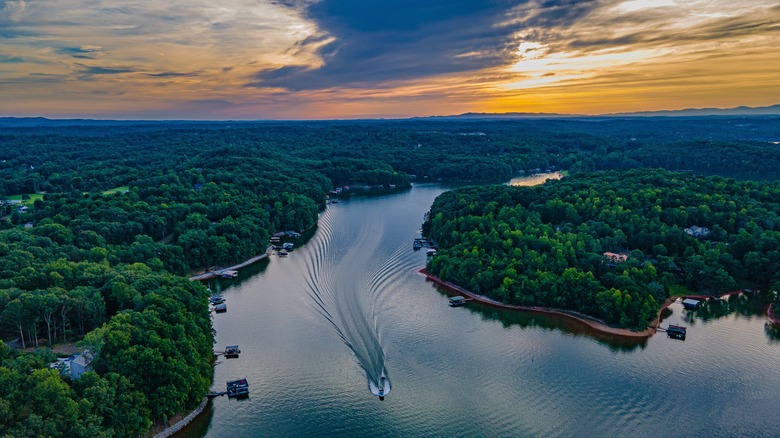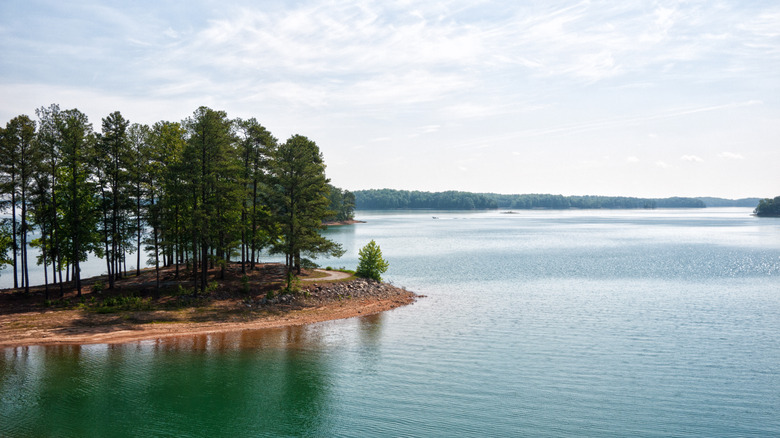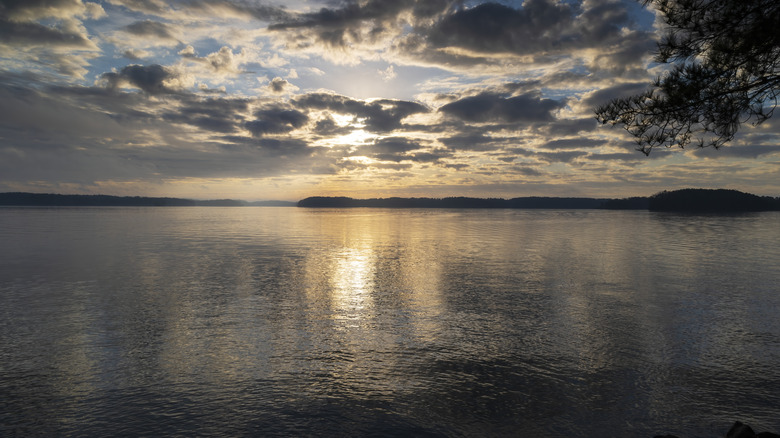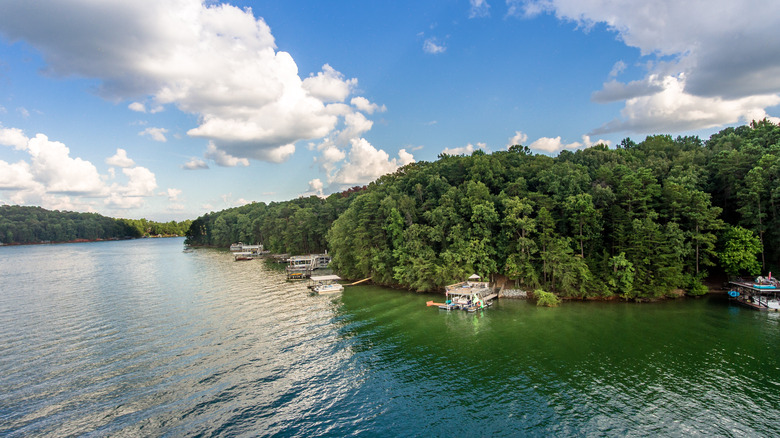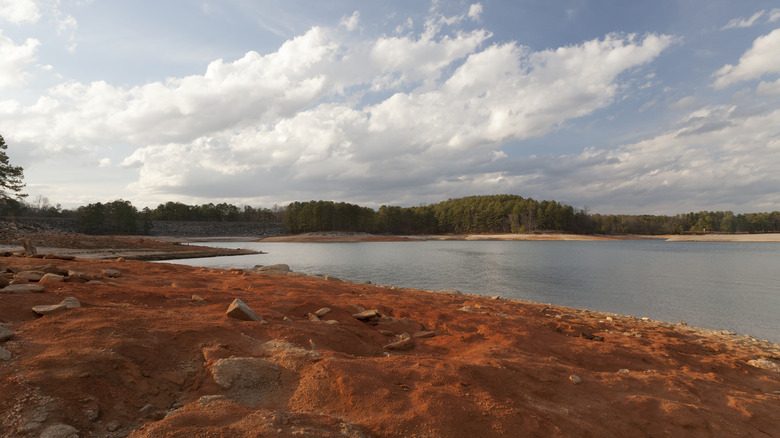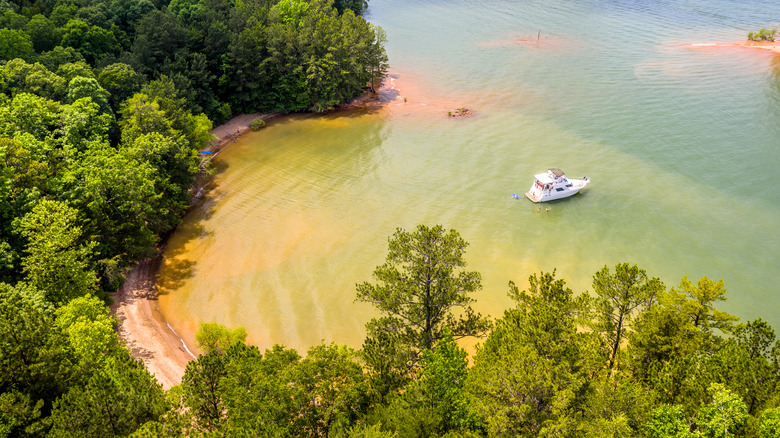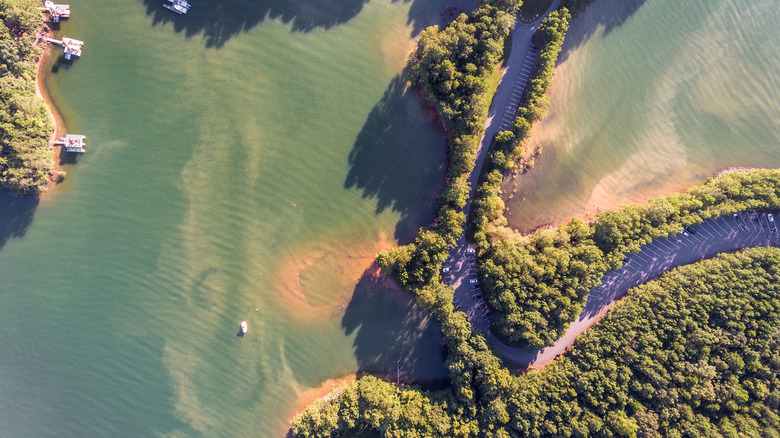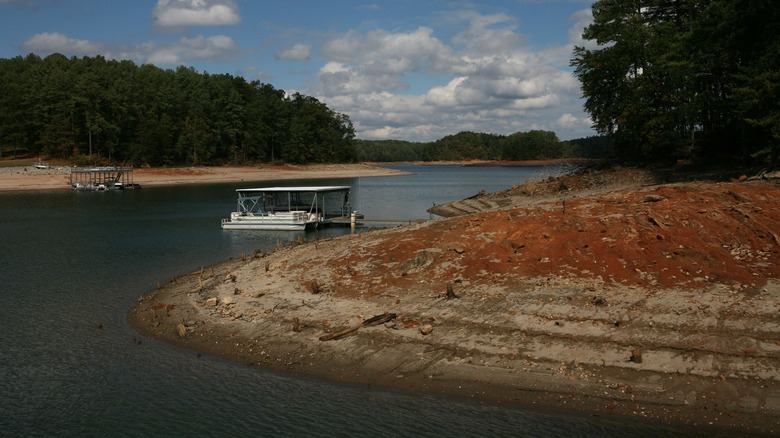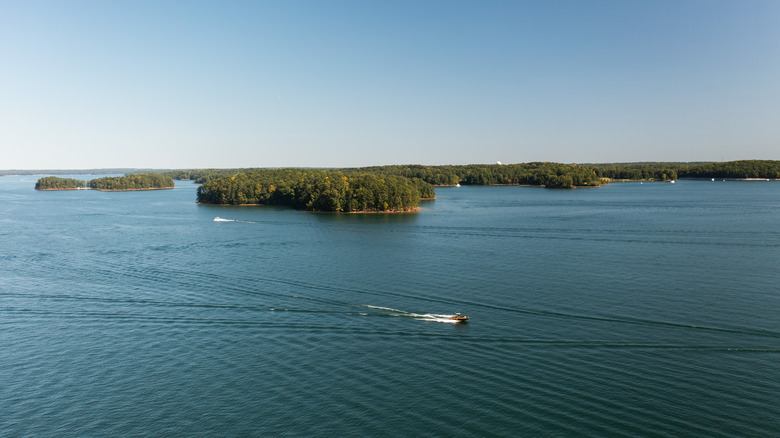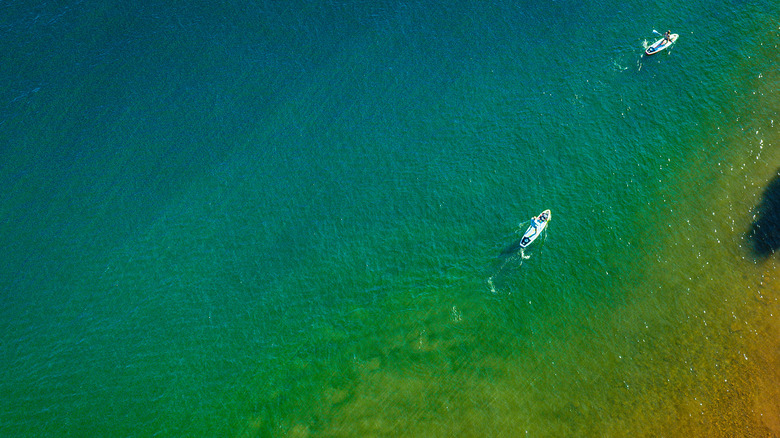The Grim And Mysterious History Of Lake Lanier's Many Deaths
A lake doesn't necessarily have to be a dangerous place. In the United States, thousands of people travel to lakes across the country to take a cooling dip during the hot summer months. But there's one lake in particular that's gained a notorious reputation for being an especially dangerous body of water, if not outright haunted.
Lake Lanier, located in the state of Georgia, isn't a naturally occurring lake and was created by the United States government in the mid-20th century. But up through its creation, the region that became Lake Lanier witnessed numerous expulsions as people were repeatedly forced out of their homes.
This tragic history, coupled with some of the early accidents at Lake Lanier, has fueled rumors that the lake itself might be haunted. Regardless of whether or not this is true, Lake Lanier has an astonishingly high mortality rate compared to other nearby lakes. Although there are many factors contributing to the high rate of fatalities at Lake Lanier, ranging from people under the influence of alcohol to difficult rescues due to low visibility, local officials still can't really explain why there are so many deaths at Lake Lanier. But one thing's for sure: It helps to wear a life jacket.
The creation of Lake Lanier
Up until the early 19th century, the area that became Lake Lanier in Georgia was a dry, unflooded region populated largely by the Cherokee Nation. After the Cherokee people were expelled from the region between 1830 and 1850 in what became known as the Trail of Tears, the area was populated by both Black and white people who settled there after the Civil War.
The region became Forsyth County, and until the early 20th century, roughly 1,100 Black people owned land in the area in a community known as Oscarville. But a second expulsion occurred in 1912 when a white lynch mob murdered 24-year-old Robert "Big Rob" Edwards and attacked the Black residents of Oscarville, forcing them to flee the county, according to Oxford American. Subsequently, the white residents of Forsyth County took possession of the land using a legal principle known as adverse possession, writes Georgia Exhibits.
Roughly 40 years later, a third expulsion came in the form of the United States Army Corps of Engineers, who decided to make a lake near Atlanta, Georgia, in order to provide, among other things, hydroelectric power, water, and flood protection to nearby counties. But according to CNN, although the government offered people some money in exchange for the land, the families were ultimately unable to survive on the money from the government. In total, roughly 700 families sold 56,000 acres of land to the U.S. government, and the rest was taken as part of eminent domain justification.
A cursed lake?
The lake was created in the 1950s by building the Buford Dam on the Chattahoochee River and gradually flooding part of Forsyth County, Georgia, including the former Oscarville. Although the Army Corps of Engineers removed some of the larger structures and trees from the area, many features, such as the cemetery, the auto-racing track, and the foundations of small buildings, were left behind and flooded over.
In total, it took just over eight years for both the dam to be constructed and the lake to be filled to capacity. But the fact that some of the cemetery was left behind, including unmarked graves, quickly led to rumors that the lake is cursed. Although the Army Corps tried to move some of the marked graves, they didn't necessarily have the technological capabilities to identify all of the unmarked burial sites.
According to author Lisa M. Russell, per Mic, the graves of countless people, including former Cherokee residents and Black enslaved people, were covered up in the gradual flooding. By the time the lake was completely filled, it reached depths of up to 160 feet. Since being filled, Lake Lanier is used to provide drinking water to over five million people.
The Lady of the Lake
One of the earliest accidents at Lake Lanier occurred less than a year after the lake's official dedication. The lake wasn't even fully filled when Delia May Parker Young and Susie Roberts' car veered off a bridge and into the lake in April 1958. Initially, the two women were labeled as missing because the bodies were nowhere to be found.
It took a year for one of the bodies to be discovered, but by the time it was found it was so decomposed that it was unidentifiable. Almost four decades later, in 1990, when the remains of the car were discovered along with the body of Roberts, the first unidentifiable body was determined to have belonged to Parker Young.
Since their car disappeared into Lake Lanier in 1958, some people have claimed to have seen the ghost of one of the women, though accounts vary as to which woman it is, wandering the bridge in a blue dress, creating the legend of the Lady of the Lake, a name taken from Arthurian legend. According to The Georgia Sun, the Lady of the Lake is said to be missing her hands and will try to lure people into drowning in Lake Lanier, pulling anyone who gets too close down into the murky depths of the lake.
The deadliest day at Lake Lanier
Christmas Day 1964 is considered to have been the deadliest day in Lake Lanier's history. Two families, the Rogers and the Browns, were on their way to an apple orchard in Mr. Brown's station wagon when the car spun out of control and crashed into the lake, reports The New York Times. Some witnesses later claimed that Mr. Brown, the driver of the station wagon, had been drinking heavily before the accident.
In total, there were 11 people in the car, including four adults, and more than half of them lost their lives that Christmas Day. While Mr. and Mrs. Rogers survived the accident, two of their three children drowned in the lake, as did Mrs. and Mr. Brown and three of their four children.
In one fell swoop, seven people had drowned in Lake Lanier. 11Alive writes that although several people jumped into the lake and divers were brought in to attempt a rescue, they were unable to see anything in the 30 feet of dark waters that submerged the car. Before long, the rescue attempt turned into a recovery operation, with witnesses and would-be rescuers at times mistaking the bodies of children for dolls.
The death of Kile Glover
In July 2012, Lake Lanier claimed another victim when 11-year-old Kile Glover died after he was hit by Jeffrey Simon Hubbard on a jet ski. Glover was being pulled around the lake with his friend on an inner tube connected to the boat when Hubbard crashed into the two children while driving around the lake on his jet ski. Glover, son of fashion stylist Tameka Raymond, was flown to Atlanta's Children's Healthcare at Egleston, but he subsequently died of heart failure within two weeks of the accident.
Since the accident, Glover's mother, Raymond — Usher's ex-wife — has called for Lake Lanier to be drained and cleaned, stating that such action "is not only necessary but also an opportunity to honor the memory of those who have lost their lives and prevent further tragedies," reports the Associated Press.
The Atlanta Journal-Constitution writes that in 2014, Hubbard was found guilty on several counts, including homicide by vessel, reckless operation, and unlawful operation of personal watercraft, and was sentenced to four years in prison and 15 years of probation. And unfortunately, this was neither the first nor the last fatal boating and drowning accident on Lake Lanier. Between 1994 and 2018, there were more than 170 boating and drowning deaths recorded at Lake Lanier.
Boat collisions
Among boating accidents, fatal boat collisions make up many of the deaths on Lake Lanier. In June 2012, two boys aged 9 and 13 were killed when Paul Bennett's fishing boat smashed into the front of their pontoon boat, reports the Athens Banner-Herald. Jake and Griffin Prince were in the boat with 11 other people, including their mother and two other children who sustained serious injuries but ultimately survived the crash.
While the body of 9-year-old Jake Prince was found quickly, divers and sonar crews were called in the day after the accident to continue searching for the body of 13-year-old Griffin Prince, according to The Florida-Times Union. Unfortunately, rescue teams faced difficulties because they didn't know exactly where on the lake the accident occurred. The following year, Bennett was found guilty of boating while drunk, reckless conduct, and failing to offer help. However, he was acquitted of homicide charges.
More recently, in the summer of 2023, a 10-year-old girl broke her leg after two boats crashed into each other on Lake Lanier, writes WSB-TV. And boating collisions aren't limited to the summer months. In January 2013, a fishing boat crashed into a four-man shell on the lake, per Lake Lanier. Luckily, everyone survived, but four people who fell into the water all ended up with hypothermia as a result.
Boat fires
Boat collisions aren't the only things that cause fatalities on Lake Lanier. Boat fires are actually a much more common cause than might initially be expected. Over the years, there have been several boat fires and boat explosions on the lake, leading to numerous injuries. Although no one has died yet has a result, the resulting injuries have sometimes been incredibly serious.
WSB-TV reports that in May 2021, on Mother's Day, a boat explosion led to two teenagers receiving serious burns. The Coleman family was on a boat at the refueling dock when their vessel exploded as Steve Coleman tried to start the engine. All six people on the boat suffered injuries, but two of the teenagers, 16-year-old Taylor and 13-year-old Gunner, suffered from injuries so severe that they were airlifted to a hospital. And Taylor was in the hospital for a month as a result of the explosion. Just two months later, in July 2021, another boat fire resulted in two people being taken to the hospital, according to The Gainesville Times.
According to Now Habersham, between 2021 and 2023, there have been at least four boat fires on Lake Lanier. In July 2022, there was another boat fire on the lake that led to two people sustaining minor injuries.
Dying from electrocution
Even with all the fires and explosions, they may not be the most dangerous things about Lake Lanier. When Thomas Milner died in Lake Lanier in July 2023, he didn't die simply from drowning. Instead, it was drowning brought on by the fact that the water was electrified, an experience known as electric shock drowning.
Soon after 24-year-old Milner jumped into Lake Lanier in the middle of summer, a frequent activity of his and not one typically associated with electrocution, he started screaming for help. NBC News reports that when a neighbor went into the water to try to save Milner, he realized that there was an electrical current running through the water. Although the neighbor ran to turn off the power box responsible for the electrical current and retrieve him from the water, Milner was declared dead at the hospital. Typically, the power box was responsible for supplying energy for the boat lift.
According to Lakeside on Lanier, electric shock drowning is a legitimate risk on Lake Lanier. In 2019, at least four docks were found to be leaking electricity into the water. With electric shock drowning, although drowning is ultimately responsible for the death, the electric currents end up paralyzing and injuring people, increasing the likelihood of drowning.
The disappearance of Kelly Nash
Unfortunately, not all of the fatalities discovered at Lake Lanier have a clear explanation, like the puzzling death of Kelly Nash. In January 2015, Nash disappeared from his home in Buford, Georgia, leaving behind his cellphone, wallet, ID, and truck, reports NBC News. According to his girlfriend, he was in bed and coughing during the night, but several hours later she awoke to find him gone.
Although there was an exhaustive search by police and Nash's family and friends, they were unable to find any trace of him. And other than a gas station surveillance video of Kelly the night before he disappeared, there was little evidence to go on. It wouldn't be until one month later, in February, that Nash's body was discovered in Lake Lanier by a fisherman. Two months later, it was disclosed that Nash's body was found with a gunshot wound.
Although it was reported that a 9mm handgun and clip were missing from Nash's home at the time of his disappearance, Nash's official cause of death was found to be drowning and it's not clear exactly what role the gun played in his death. As of 2023, the exact circumstances of Nash's death have yet to be determined.
Over 500 deaths
Since the creation of Lake Lanier, more than 500 people have died in its waters. Some outlets report that as of 2023 that number had climbed as high as 700, but according to The Independent this number is unconfirmed. But even at 500, the number of deaths is staggering. And it's not necessarily due to the large number of people who visit the lake. Both Lake Lanier and the nearby Lake Allatoona, also in Georgia, receive roughly 11 million visitors every year. But Lake Allatoona has about a third of the number of fatalities that Lake Lanier has.
And it doesn't seem like the lake is getting safer as time goes on, considering that at least 200 of the 500 deaths at Lake Lanier have occurred since 1994. The fact that the lake is filled with rubble and objects left over from before the lake was flooded also makes diving rescue missions comparatively difficult. But local officials put the blame on individuals, claiming that fatalities typically occur when people swim or boat under the influence of alcohol or fail to take proper safety precautions. According to Sgt. Mark Burgamy, Georgia Department of Natural Resources supervisor at Lake Lanier, "In my 17 years in doing this, I've never seen a drowning victim with a life jacket on," per The Gainesville Times.
A deadly year at Lake Lanier
In 2023 alone, eight people died at Lake Lanier, with WSB-TV reporting that this was the deadliest year on record since 2019, a year which also recorded eight deaths in a single 12-month period. In one weekend alone in 2023, there were three fatal accidents. According to Atlanta News First, the same July weekend that Thomas Milner died from electric shock drowning, 61-year-old Tracey Stewart also drowned in Lake Lanier after jumping into the lake from a boat. In a separate incident, 27-year-old Leonardo Martinez vanished while swimming; Martinez's body was found several days later.
A rapid-fire string of tragedies followed: In August, 22-year-old Bryan Tarasona died after he disappeared beneath the waters of Lake Lanier while swimming with friends. In September, 23-year-old Gavrie Whitlock slipped while running on the dock, fell into the water, and drowned. The following month, Walter Juarez Guardado went missing in Lake Lanier after jumping from a sinking jet ski and attempting to swim to shore. His body was recovered two days later.
Unfortunately, this is not the highest number of deaths that Lake Lanier has seen in a single year. In 1999 alone, 11 people died in Lake Lanier, while 2011 and 2014 saw 10 people each year lose their lives in the lake.
